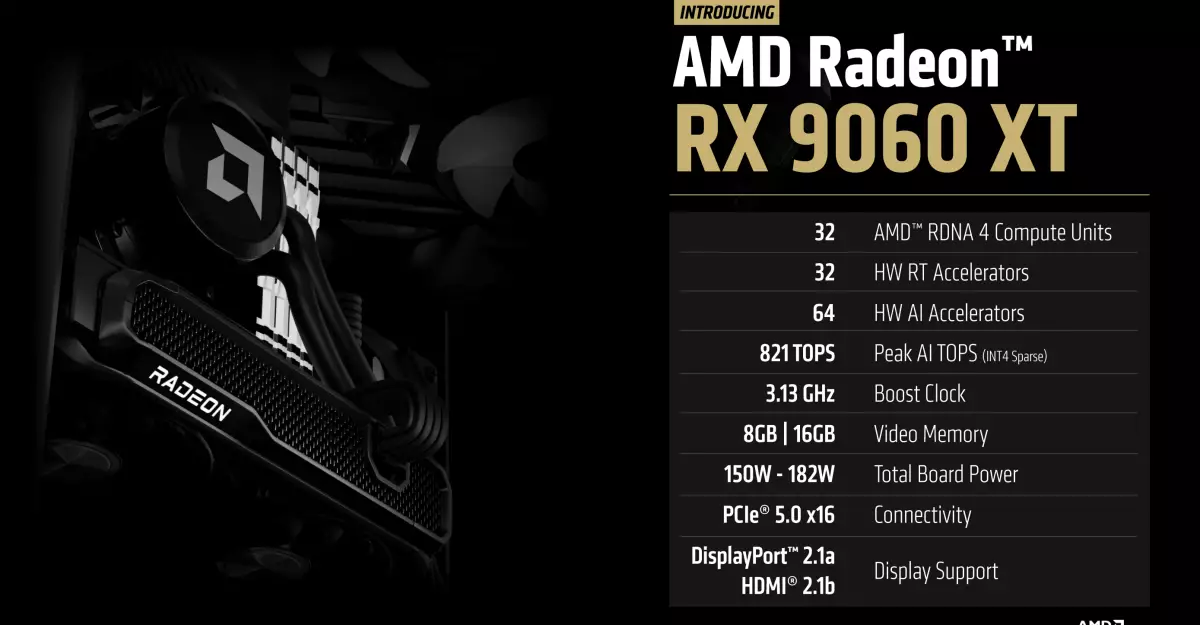The announcement of AMD’s Radeon RX 9060 XT at this year’s Computex has sparked considerable conversation in the tech community. This new graphics card aims to throw down the gauntlet against Nvidia’s RTX 5060, which has drawn its fair share of scrutiny, primarily due to its controversial 8GB VRAM specification. AMD’s decision not to reveal specific pricing or a release date may indicate the company’s strategic approach to generate buzz rather than focus on immediate sales figures. Given the relentless pace of technological advancements, it’s crucial for AMD to position itself as a strong contender in the gaming graphics arena.
Hardware Specs: Power Under the Hood
Equipped with 32 RDNA 4 compute units, the RX 9060 XT boasts an impressive boost clock of 3.13GHz, showcasing AMD’s commitment to delivering high-performance hardware. The total board power, ranging from 150 to 182 watts, suggests that the RX 9060 XT can handle demanding gaming sessions, although its power consumption remains moderate compared to some of its competitors. Furthermore, the inclusion of DisplayPort 2.1a and HDMI 2.1b support ensures that this GPU is future-proofed for upcoming gaming innovations. These specifications provide a tantalizing glimpse of what gamers might expect, but the question of whether these improvements will translate into tangible performance gains remains unanswered.
The Controversial 8GB VRAM Debate
What truly underlines the current debate surrounding both AMD and Nvidia’s offerings is the 8GB VRAM standard. In 2025, this capacity is increasingly seen as inadequate for the demands of modern gaming, prompting discussions about whether either company is prioritizing profits over performance. As recent titles continue to push the limits of graphical fidelity, the shared decision to equip their next-gen GPUs with limited memory has drawn criticism from both consumers and tech experts alike. This situation requires a careful examination of how both companies manage expectations against the backdrop of evolving gaming needs.
Nvidia’s Strategic Maneuvers: A Missed Opportunity for Transparency?
Nvidia’s approach in handling pre-release reviews for the RTX 5060 has raised eyebrows across the gaming community. By restricting access to necessary drivers for testing, Nvidia’s tactics paint a picture of a company uncertain about its product’s performance, particularly regarding the 8GB VRAM issue. Gamers Nexus has publicly challenged Nvidia’s narrative, alleging that the company pressured them into using Multi Frame Generation (MFG) features in benchmarks. Such allegations highlight a worrying trend in the tech industry—where transparency is sacrificed in favor of marketing maneuvers. This has further fueled the excitement surrounding the RX 9060 XT, making AMD’s entry both timely and critical.
Looking Ahead: AMD’s Opportunity for Market Disruption
AMD finds itself in a unique position. While its competitors may struggle with their public relations and performance metrics, AMD’s decision to wait for a release could play into the hands of savvy consumers hungry for transparency and performance. By entering the fray with a powerful GPU and potentially redefining expectations in terms of both pricing and capabilities, the Radeon RX 9060 XT could indeed become a significant player in the modern gaming landscape.

